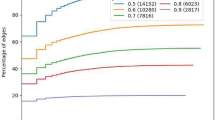Abstract
A botnet is a program designed to perform a specific task using multiple computers connected in a network. In this paper we will focus on botnets being used to distribute malicious programs. In the real world, botnets have been shown to exhibit more aggressive and sophisticated behaviour than traditional malware. Botnets are used to infect computer networks and hence their success depends on the properties of the networks. We observe the behaviour of mathematical models used to describe botnets when botnet parameters are varied to understand if such variation is beneficial to their spread. We also introduce novel models for depicting botnet behaviour using master equations. These models, unlike previous ones, address nodes of distinct categories in a network as a sequence of probability distributions rather than a value at each time interval. We also contribute visualisations for these models. This paper is a substantial expansion of unpublished work the first author performed while on a Nuffield student research placement, with the second author the project supervisor.
Access this chapter
Tax calculation will be finalised at checkout
Purchases are for personal use only
Similar content being viewed by others
References
Ajelli, M., Lo Cigno, R., Montresor, A.: Compartmental differential equation models of botnets and epidemic malware (extended version), University of Trento report T.R. DISI-10-011, 2–3, 9 (2010)
Anon: Internet Census 2012: Port Scanning/0 Using Insecure Embedded Devices (2013). (Carna Botnet) http://census2012.sourceforge.net/paper.html
CAIDA Datasets. http://www.caida.org/research/security/#Datasets
Dagon, D., Zou, C., Lee, W.K.: Modeling botnet propagation using time zones. In: Proceedings of the 13th NDSS, vol. 6, pp. 2–13 (2006)
Keeling, M.: Population Dynamics MA4E7, Warwick University, 50 (2004). http://homepages.warwick.ac.uk/~masfz/Pop_Dyn/Handouts.pdf
Lin, M., Ongtang, M., Rao, V., Jaeger, T., McDaniel, P., La Porta, T., Traynor, P.: On cellular botnets: measuring the impact of malicious devices on a cellular network core. In: Proceedings of the 16th ACM Conference on Computer and communications Security, pp. 223–234 (2009)
Nordlohne, C.: Measuring Botnet Prevalence: Malice Value, preprint (2015). http://acdc-project.eu/wp-content/uploads/2015/05/malice-value2.pdf
Rajab, M., Zarfoss, J., Monrose, F., Terzis, A.: My botnet is bigger than yours (Maybe, Better than Yours): why size estimates remain challenging. In: Proceedings of the 1st USENIX Workshop in Hot Topics in Understanding Botnets, April 2007
Rodionov, E., Matrosov, A.: The Evolution of TDL: Conquering x64, eSeT (2011). https://www.welivesecurity.com/media_files/white-papers/The_Evolution_of_TDL.pdf
Rohloff, K., Başar, T.: Stochastic behavior of random constant scanning worms. In: Proceedings of the 14th International Conference in Computer Communications and Networks, pp. 339–334 (2005)
Rrushi, J., Mokhtari, E., Ghorbani, A.: Early stage botnet detection and containment via mathematical modeling and prediction of botnet propagation dynamics. University of New Brunswick Technical report TR10-206 (2010)
Song, L.P., Jin, Z., Sun, G.Q.: Modeling and analyzing of botnet interactions. Physica A 390, 347–358 (2011)
Acknowledgements
The authors acknowledge the kindness of the Nuffield Foundation for making this work possible, and the generous research support of Plymouth University.
Author information
Authors and Affiliations
Corresponding author
Editor information
Editors and Affiliations
Rights and permissions
Copyright information
© 2017 Springer International Publishing AG
About this paper
Cite this paper
Dash, W., Craven, M.J. (2017). Exploring Botnet Evolution via Multidimensional Models and Visualisation. In: Livraga, G., Mitchell, C. (eds) Security and Trust Management. STM 2017. Lecture Notes in Computer Science(), vol 10547. Springer, Cham. https://doi.org/10.1007/978-3-319-68063-7_5
Download citation
DOI: https://doi.org/10.1007/978-3-319-68063-7_5
Published:
Publisher Name: Springer, Cham
Print ISBN: 978-3-319-68062-0
Online ISBN: 978-3-319-68063-7
eBook Packages: Computer ScienceComputer Science (R0)




